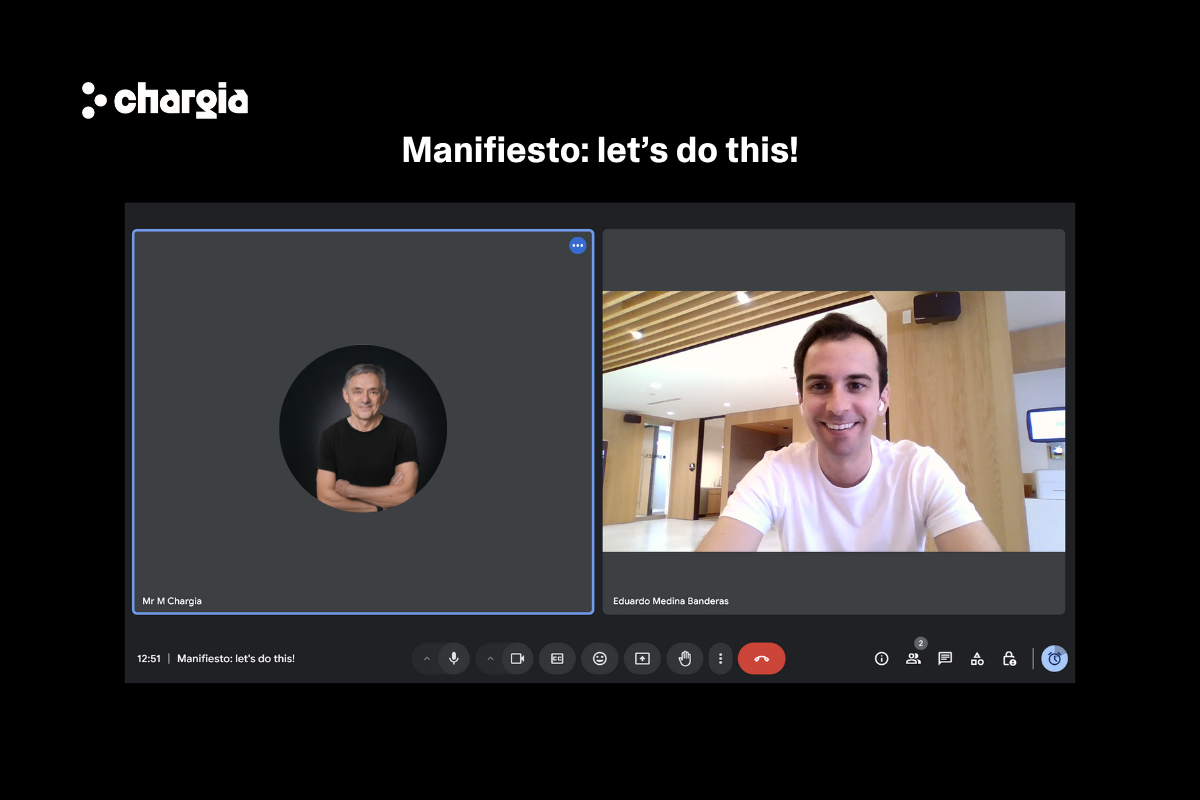Manifiesto: Focused on the EV User Experience – A Conversation with Our CEO, Eduardo Medina
Introduction
The transition to electric vehicles (EVs) is accelerating, yet the industry still faces major challenges—especially when it comes to charging infrastructure and user experience. At Chargia, we believe that solving these challenges requires a user-first approach, leveraging technology to ensure that every EV driver gets the support they need, when they need it.
To dive deeper into this vision, we sat down with Eduardo Medina, CEO of Chargia to discuss his journey in the EV space, the biggest challenges in charging, and how artificial intelligence (AI) is set to revolutionize the industry.
How did your journey start, and what key insights have you gained from your hands-on experience working in electric mobility?
Eduardo Medina:
My journey in electric mobility began in 2020, and over the years, I’ve had the opportunity to gain first-hand experience in multiple key areas of the EV ecosystem—from vehicle operations to charging infrastructure.
One of the defining aspects of my career has been working with an industrial partner from the automotive sector, which gave me direct exposure to OEMs, dealerships, and the challenges of EV adoption. This partnership allowed me to test different EV models, understand how range and battery performance affect real-world use, and identify the key friction points for users transitioning to electric mobility.
Beyond vehicles, my focus quickly expanded into charging infrastructure. I’ve worked on agreements with leading charging station manufacturers and operators, learning how different technologies and network strategies impact user experience. This experience led me to spearhead the development of a charging network with over 300 charging points, giving me valuable insight into the operational challenges of deploying and maintaining charging infrastructure at scale.
Through these experiences, I’ve seen one common thread: the EV revolution is not just about vehicles or chargers—it’s about ensuring a seamless, user-friendly experience for drivers. That’s why I’m obsessed with one fundamental question:
In your opinion, what are the biggest challenges in EV charging today?
Eduardo Medina:
I keep reading about the challenges facing the EV industry, and there’s a lot of debate around “the race to electrification.” But after analyzing the latest sales figures in key markets and witnessing the transition firsthand, I have no doubt—the future is 100% electric, or at least predominantly so.
When discussing challenges, I’ve already mentioned a major one: the lack of proper guidance in the EV sales process. But there’s another issue I’m personally obsessed with—the charging experience.
Why? Let me ask you this: Have you ever tried charging at a station in a remote town? Have you ever been at a gas station in the middle of the night? I have, and trust me, it wasn’t a great experience—I’d rather not remember it.
EV users deserve better. Charging should be simple, accessible, and stress-free no matter where you are or what time it is. That’s why Chargia exists—to revolutionize the EV charging experience and ensure that every driver, whether a seasoned EV owner or a first-time user, gets the instant support they need.
What role does AI play in improving the EV charging experience?
Eduardo Medina:
Right now, customer support in EV charging is broken. Call centers are slow, apps are clunky, and users often feel stranded when something goes wrong at a charging station. AI is the game-changer that will fix this.
With Chargia’s AI-driven system, EV drivers get real-time assistance the moment they need it. There’s no waiting on hold, no navigating confusing menus—just instant, intelligent support via WhatsApp or any other preferred messaging platform.
Here’s what AI brings to EV charging:
- Instant troubleshooting – No need to call a helpline, users get immediate step-by-step solutions.
- Real-time charger status – AI can detect faults, check availability, and guide users to the best charging option.
- Seamless integration with CPOs – Chargia’s AI doesn’t just help users—it also reduces operational costs for charge point operators by automating support.
The future of EV charging isn’t just about more infrastructure—it’s about smarter, AI-powered experiences that make charging effortless.
What’s missing in today’s EV charging networks? How can CPOs improve?
Eduardo Medina:
The biggest gap in today’s charging networks isn’t infrastructure—it’s user experience. The market keeps focusing on deploying more chargers, but what’s the point of having thousands of chargers if users struggle to use them?
Many Charging Point Operators (CPOs) are missing a key element: real-time, AI-powered customer support. Most networks still rely on traditional call centers, which are costly, inefficient, and frustrating for users.
Here’s how CPOs can step up their game:
- Prioritize seamless user support – AI-powered, instant assistance should be the standard.
- Ensure charger reliability – Predictive maintenance and real-time fault detection reduce downtime.
- Improve accessibility – Charging networks should be easy to use for both experienced EV drivers and first-time users.
CPOs that fail to address these pain points will lose customers to better-equipped networks. The ones who invest in AI-driven support and better UX will lead the market.
What’s your vision for Chargia in the next few years?
Eduardo Medina:
At Chargia, our mission is clear: to make EV charging as easy as refueling a gas car. But more than that, we want to create a seamless, intelligent, and user-first charging experience that supports the growing EV ecosystem.
In the next few years, I see Chargia becoming the global benchmark for AI-driven EV support. Our focus will be on:
- Expanding our AI assistant’s capabilities. – Making EV charging fully intuitive, reducing the need for human support.
- Integrating with more CPOs worldwide. – Bringing instant support to as many charging networks as possible.
- Bridging the knowledge gap – Educating new EV drivers so that charging is never a frustrating experience.
The EV revolution is unstoppable, and the winners will be those who understand that charging is not just about infrastructure—it’s about making the entire experience effortless.
That’s exactly what Chargia is here to do.


